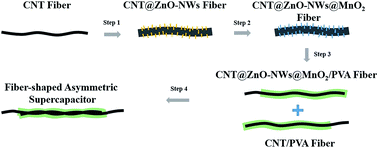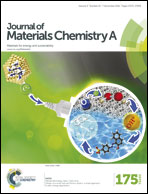Fiber-shaped asymmetric supercapacitors with ultrahigh energy density for flexible/wearable energy storage†
Abstract
Fiber-shaped supercapacitors (FSCs) have attracted significant interest owing to their unique advantages of small size, light weight, high flexibility, and capability of being integrated into wearable electronics and smart textiles. Their main limitation, however, is their low energy density when compared with batteries. Here a fiber-shaped asymmetric supercapacitor (FASC) with high energy density has been developed successfully using CNT@ZnO-NWs@MnO2 fibers as the positive electrode and CNT fibers as the negative electrode. Due to the high capacitances and excellent rate performances of CNT@ZnO-NWs@MnO2 fibers and CNT fibers, such an asymmetric cell exhibits superior electrochemical performances. An optimized FASC can be cycled reversibly in the voltage range of 0–1.8 V, and exhibits a maximum energy density of 13.25 μW h cm−2, which is much higher than those reported for fiber-shaped supercapacitors. Owing to the rational structure design, the all-solid-state FASCs demonstrate excellent mechanical and electrochemical stability. Over 1000 bending cycles, 96.7% of the initial capacitance can still be retained.


 Please wait while we load your content...
Please wait while we load your content...